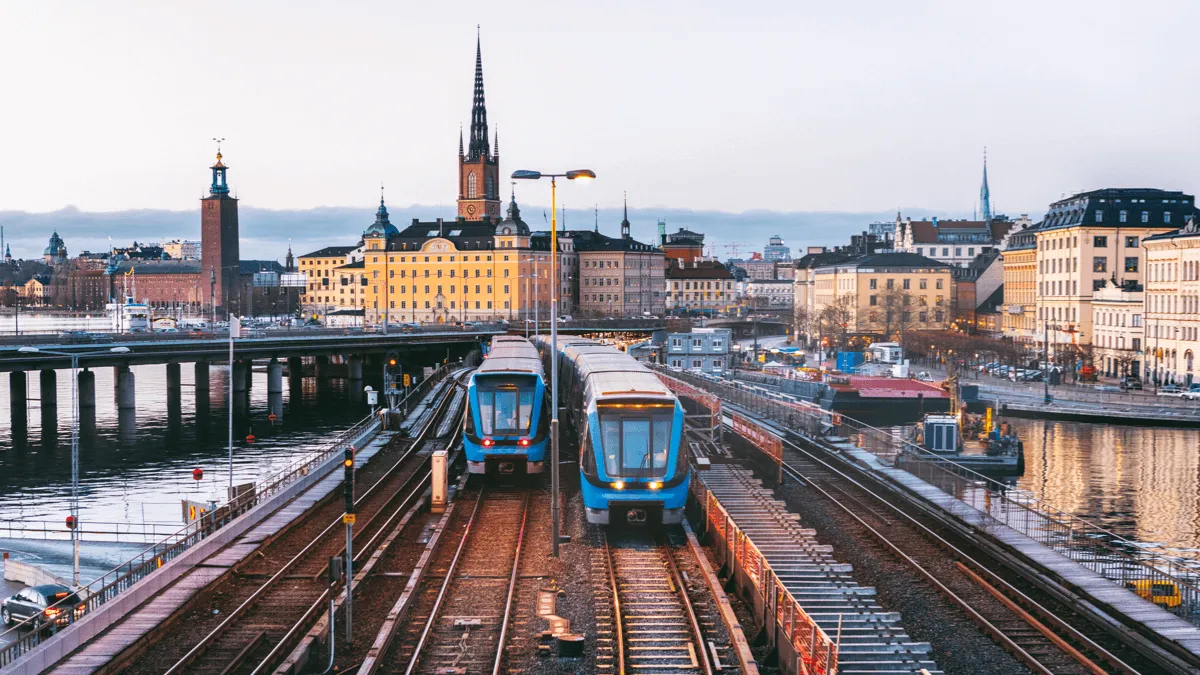Navigating Stockholm: A Complete Guide to the City’s World-Class Transportation System
Stockholm’s world-class transportation system makes it easy to explore the city and beyond. From the metro and buses to bike-sharing and scenic ferries, each option offers convenience, affordability, and sustainability, ensuring you can navigate Stockholm’s vibrant neighborhoods with ease.

Stockholm is a city renowned not only for its picturesque islands, historic architecture, and vibrant culture but also for its world-class public transportation system. With over 850,000 Stockholmers relying on public transport every day, the city boasts one of the most efficient and accessible networks in Europe. In fact, nearly 80% of Stockholm’s residents utilize public transit regularly, whether it’s the metro, buses, or ferries, making Stockholm a model of sustainable urban mobility.
This guide delves into the various transportation options that make getting around Stockholm—and beyond—so convenient. We’ll explore everything from local buses and trams to long-distance trains and ferries connecting Sweden to neighboring countries. Whether you’re moving to the city or just visiting, understanding Stockholm’s transit offerings, ticket options, and insider tips will help you make the most of your journey through this stunning Scandinavian capital.
Looking to make your move to Stockholm seamless? Hemavi is here to help. With our expertise in expat housing, we simplify finding your perfect home in the city. Let us handle the logistics so you can focus on exploring Stockholm's neighborhoods and getting around with ease.
Public Transportation in Stockholm
Stockholm is celebrated for its efficient, environmentally friendly, and user-friendly public transportation network. Nearly 80% of Stockholmers rely on public transit regularly, highlighting its convenience and efficiency. Managed by SL (Storstockholms Lokaltrafik), the system encompasses multiple modes of transport, seamlessly connecting the city’s islands, suburbs, and neighboring areas.
To make the most of Stockholm’s transit options, consider purchasing an SL Access Card (20 SEK), a reusable smart card that you can load with single tickets, travelcards, or pay-as-you-go credit. Travelcards offer the best value if you plan to use public transit frequently, providing unlimited access to all SL modes within Stockholm County.
As a newcomer, understanding these options will allow you to explore Stockholm
Metro (Tunnelbana) in Stockholm
The Stockholm Metro, or Tunnelbana, is often considered the backbone of the city’s transportation system. It consists of three main lines—Green, Red, and Blue—with approximately 100 stations covering the city and suburban areas, used by an estimated 1.2 million passengers on a daily basis. The metro’s unique feature is its art: nearly 90 stations showcase murals, sculptures, and mosaics, creating what is known as the “world’s longest art gallery.”
The cost for a single journey is 42 SEK for adults, and its ticket is valid for 75 minutes across all SL services. If you're planning on using the metro regularly, you may want to invest in one of the following Travelcards, which offer unlimited travel in Stockholm County:
- 24-hour: 155 SEK
- 72-hour: 310 SEK
- 7-day: 405 SEK
- 30-day: 930 SEK
Buses in Stockholm
Stockholm’s bus network fills in the gaps where metro coverage is limited, particularly in suburban and residential areas. Buses are well-coordinated with metro schedules, ensuring efficient transfers and comprehensive city-wide access. The buses are an essential part of public transit, with frequent service, especially during peak hours, and many routes operate on a 24-hour basis.
All the buses are wheelchair accessible, and run across hundreds of stations all around Stockholm County. Tickets are included with any SL travelcard, allowing unlimited transfers within the valid time period. Single-journey tickets also apply across buses, metro, trams, and commuter trains.
Trams in Stockholm
Trams offer a unique and scenic way to explore central Stockholm, with Djurgårdslinjen (Line 7) and Tvärbanan (cross-city tram) being the most famous routes. Line 7 connects the bustling city center to Djurgården Island, home to many popular attractions, including the Vasa Museum and Skansen. Trams are also equipped for accessibility and are a popular choice for tourists and locals alike who prefer above-ground travel to enjoy the sights of the city.
Similar to buses, standard SL tickets and travelcards apply, making trams accessible to anyone holding an SL travelcard or valid single journey ticket.
Commuter Trains (Pendeltåg) in Stockholm
The Pendeltåg commuter trains connect Stockholm with its surrounding suburbs and neighboring counties, making them ideal for longer regional trips. The trains have dedicated tracks separate from the metro, enabling high-speed connections to areas like Uppsala, Södertälje, and Arlanda Airport. Many professionals and students living outside central Stockholm rely on Pendeltåg for daily commutes.
Commuter trains cover beyond Stockholm County, so SL tickets and travelcards are valid within Stockholm County, but trips extending beyond require an additional ticket or fee.
Ferries in Stockholm
Given Stockholm’s unique geography, ferries are integral to the transit system. SL-operated ferries serve as both practical transport and scenic routes connecting Stockholm’s islands. The Djurgården Ferry is the most popular, running between Slussen and Djurgården, where you can find some of Stockholm’s iconic cultural sites. Seasonal ferries also offer routes to the Stockholm Archipelago, a favorite for weekend escapes.
Ferries fall under the SL ticketing system, meaning SL travelcards cover ferry rides within Stockholm’s public transit area. Archipelago routes may require separate tickets, often with discounts available for SL pass holders.
Biking in Stockholm
Sweden is a bike-friendly country, with Stockholm and other cities offering extensive infrastructure to support biking as a sustainable and healthy mode of transportation. In Stockholm, biking is a popular choice for short commutes and daily errands. The city has invested heavily in bike lanes and secure bike parking facilities, making it easy for residents to integrate biking into their routines.
Stockholm has over 1,000 kilometers of bike lanes, ensuring safe routes throughout the city. Many roads have dedicated bike lanes, and shared paths are clearly marked to keep cyclists and pedestrians safe. Around 30% of Stockholmers use bikes regularly, especially during warmer months. Biking becomes less common in winter due to icy conditions, but many residents continue to ride year-round, aided by specialized winter tires and proper gear.
Buying a new commuter bike ranges from 3,000 to 10,000 SEK. Second-hand bikes can be found for around 1,000 to 3,000 SEK on platforms like Blocket or Facebook Marketplace. Some areas have free bike parking, while others require fees for more secure, indoor options. Monthly passes for secure bike storage are around 100 SEK. If you're not ready to invest in a bike, you can also opt for the rental option, which ranges around 300 SEK per month.
Traveling Around Sweden
Trains Across Sweden
Sweden’s train network, primarily operated by SJ (Swedish Railways), is known for its comfort, speed, and coverage across the country. Over 130,000 travelers use SJ’s services daily. Prices vary based on the distance and timing. Early bookings often yield discounted fares, and it’s possible to find one-way tickets for as low as 195 SEK if booked in advance. A standard ticket from Stockholm to Gothenburg ranges from 495 to 895 SEK.
SJ offers youth and student discounts, as well as a 25% discount for seniors (65+). Additionally, Sweden’s commitment to sustainable travel means tickets purchased on trains are often subject to environmentally focused incentives, such as CO2 offsetting. Some of the train options include:
- High-Speed Trains (X2000): The X2000 trains are the fastest in Sweden, connecting major cities like Stockholm, Gothenburg, and Malmö. With speeds of up to 200 km/h, the X2000 offers a quick and comfortable journey across long distances.
- Regional and Intercity Trains: These trains connect cities and towns, making it easy to reach destinations beyond the main urban hubs.
- Night Trains: For longer routes, like Stockholm to the northern city of Kiruna, night trains are available, allowing passengers to sleep onboard and arrive refreshed.
Buses Across Sweden
Long-distance buses are a cost-effective alternative for intercity travel across Sweden. Companies like Flixbus, and Vy offer extensive routes connecting major cities and small towns alike, often at very affordable prices. Some of their popular routes include Stockholm to Gothenburg, Malmö to Uppsala, and Stockholm to Umeå. An interesting fact is that many buses in Sweden run on biofuels, supporting the country’s goal to reduce its carbon footprint. Some companies also offer carbon-offset options when purchasing tickets.
Buses are generally equipped with free Wi-Fi, power outlets, and comfortable seating, making long journeys more enjoyable. Bus tickets are generally cheaper than train fares, with prices starting as low as 99 SEK for a one-way journey on certain routes. Discounts are often available for students, young adults under 26, and groups. Booking in advance can help secure the lowest fares, especially during peak travel times.
Domestic Flights Across Sweden
For long distances, such as from Stockholm to Kiruna in the far north or Gothenburg to Luleå, domestic flights offer the fastest travel option. Although Sweden encourages train travel to reduce environmental impact, domestic airlines provide a practical solution for those on tight schedules or needing to cover substantial distances quickly.
Main domestic carriers include SAS (Scandinavian Airlines), BRA (Braathens Regional Airlines), and Norwegian Air. Fares vary depending on the airline, season, and how far in advance you book. Typical prices for one-way tickets start at 700-1,200 SEK, with frequent promotional fares. Prices may increase significantly closer to departure dates.
Conclusion
Stockholm’s transportation system truly offers something for everyone, whether you’re navigating the city by metro, exploring new neighborhoods on a bike, or planning a weekend getaway by ferry or train. With such a variety of efficient, affordable, and environmentally conscious options, getting around Stockholm and beyond is a seamless experience, tailored to both urban dwellers and those ready to explore Sweden’s breathtaking landscapes.
If you’re preparing for a move to Stockholm, let Hemavi make finding a home just as effortless as navigating the city. As a trusted partner for expats, we help you settle in quickly and find the ideal place to call home.




Comments ()